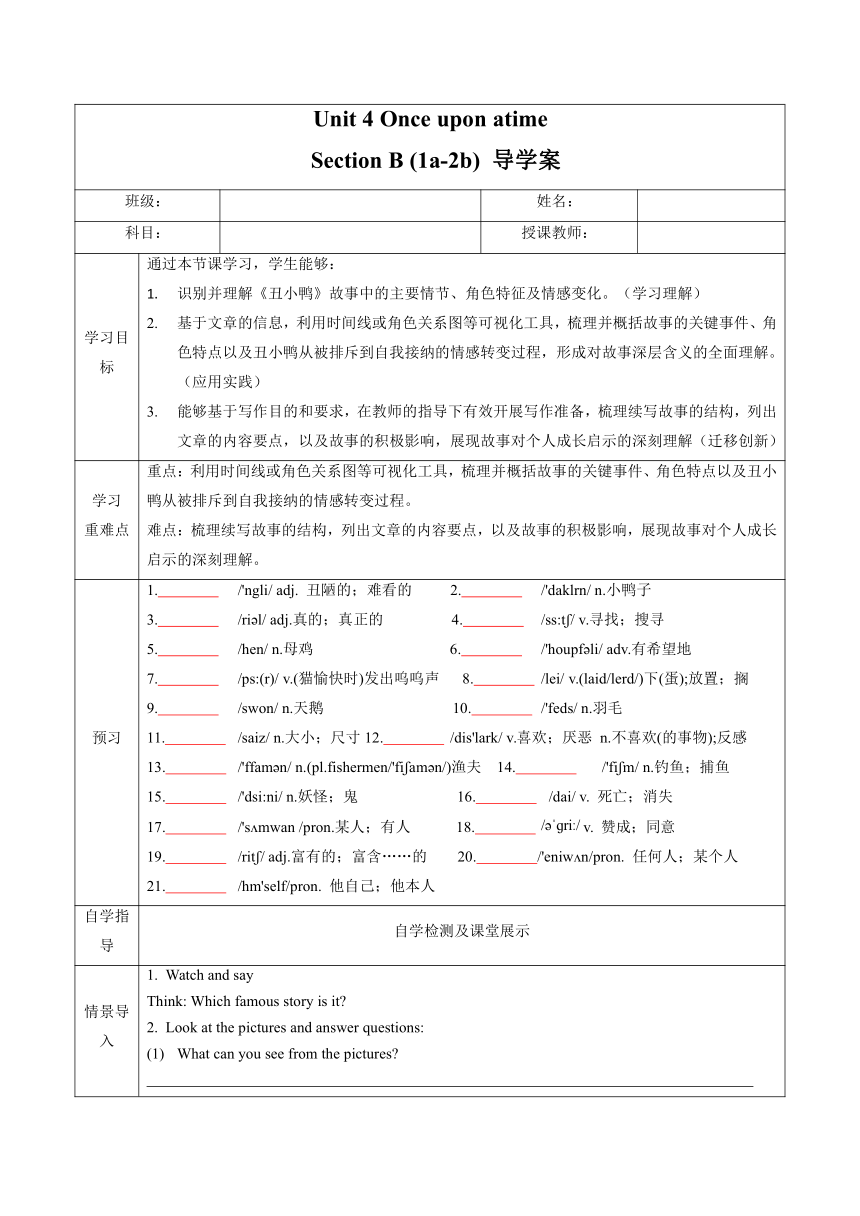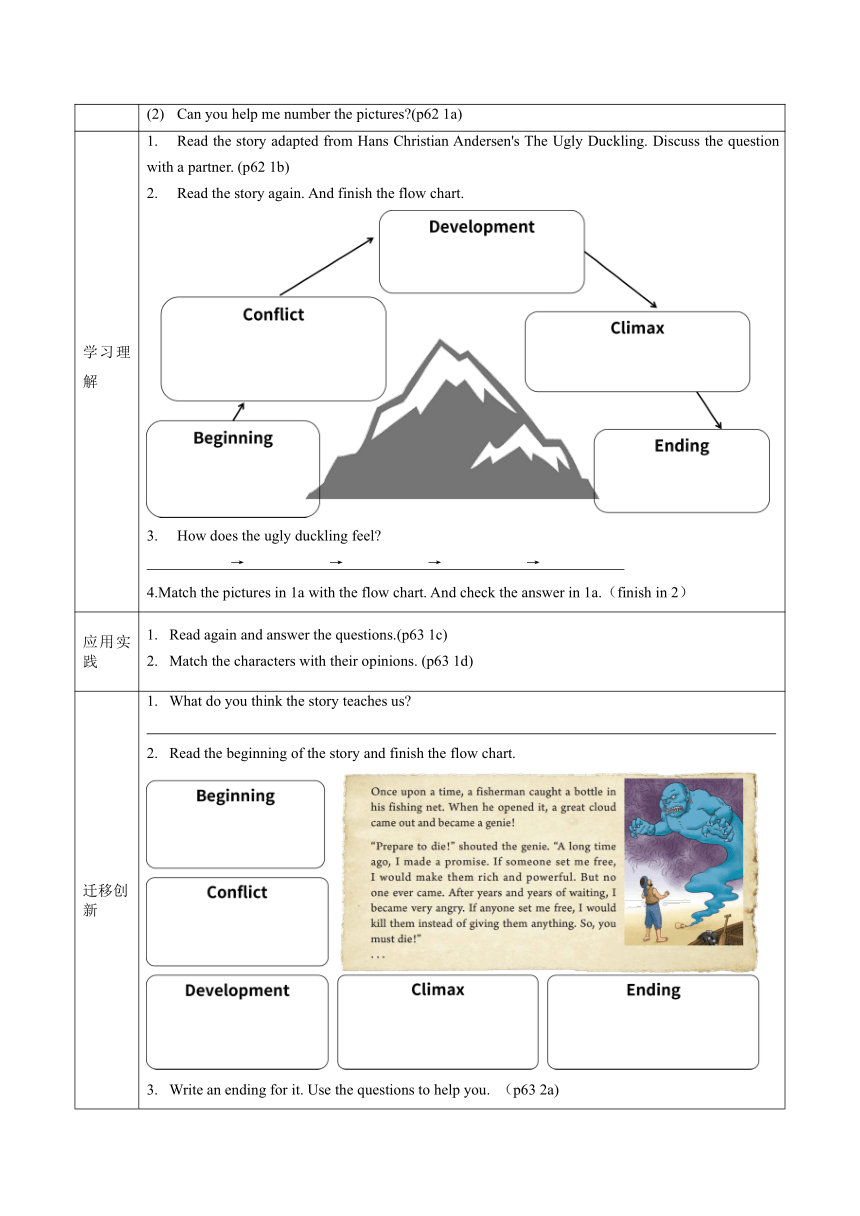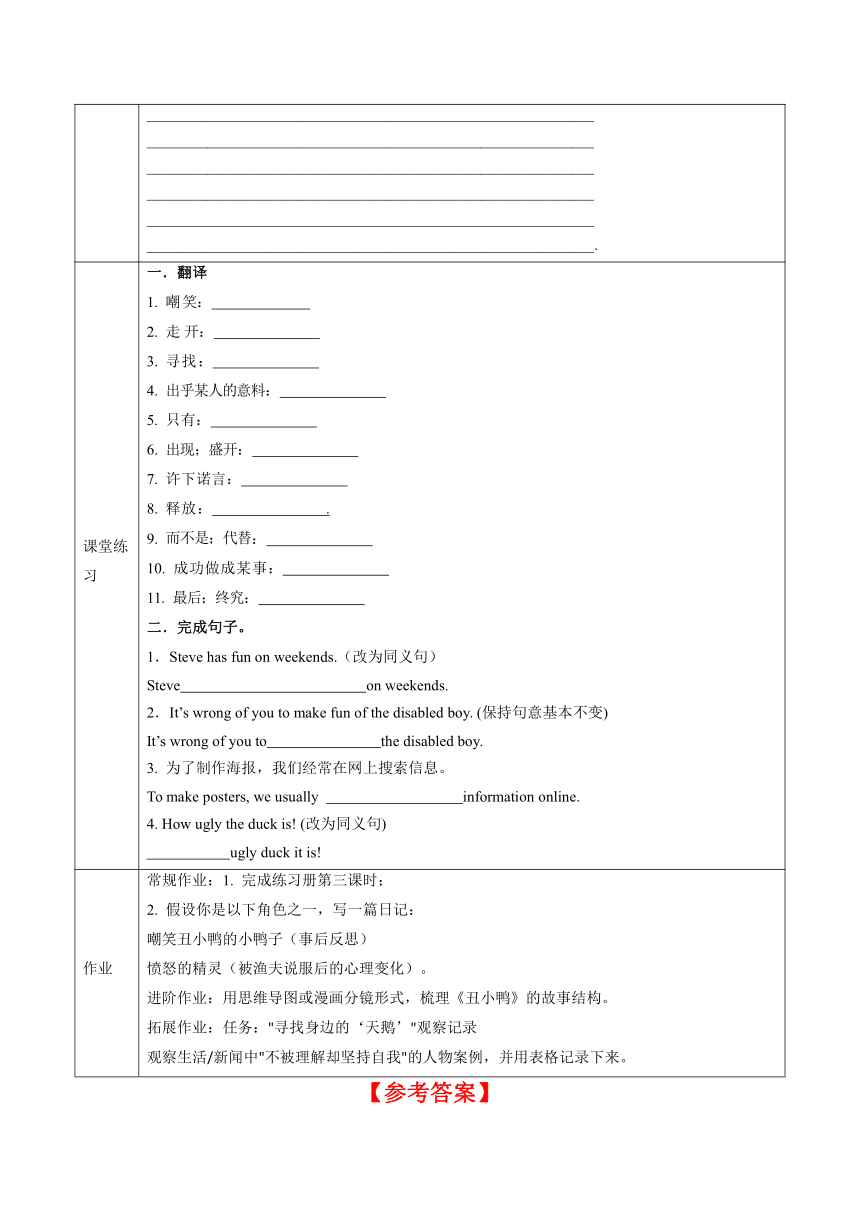Unit 4 Once upon a Time 第4课时 Section B (1a-2b)(导学案)-英语鲁教版五四学制2024七年级上册
文档属性
| 名称 | Unit 4 Once upon a Time 第4课时 Section B (1a-2b)(导学案)-英语鲁教版五四学制2024七年级上册 |  | |
| 格式 | docx | ||
| 文件大小 | 1.6MB | ||
| 资源类型 | 教案 | ||
| 版本资源 | 鲁教版 | ||
| 科目 | 英语 | ||
| 更新时间 | 2025-07-23 17:21:11 | ||
图片预览



文档简介
Unit 4 Once upon atime Section B (1a-2b) 导学案
班级: 姓名:
科目: 授课教师:
学习目标 通过本节课学习,学生能够: 识别并理解《丑小鸭》故事中的主要情节、角色特征及情感变化。(学习理解) 基于文章的信息,利用时间线或角色关系图等可视化工具,梳理并概括故事的关键事件、角色特点以及丑小鸭从被排斥到自我接纳的情感转变过程,形成对故事深层含义的全面理解。(应用实践) 能够基于写作目的和要求,在教师的指导下有效开展写作准备,梳理续写故事的结构,列出文章的内容要点,以及故事的积极影响,展现故事对个人成长启示的深刻理解(迁移创新)
学习 重难点 重点:利用时间线或角色关系图等可视化工具,梳理并概括故事的关键事件、角色特点以及丑小鸭从被排斥到自我接纳的情感转变过程。 难点:梳理续写故事的结构,列出文章的内容要点,以及故事的积极影响,展现故事对个人成长启示的深刻理解。
预习 1. /'ngli/ adj. 丑陋的;难看的 2. /'daklrn/ n.小鸭子 3. /ri l/ adj.真的;真正的 4. /ss:t / v.寻找;搜寻 5. /hen/ n.母鸡 6. /'houpf li/ adv.有希望地 7. /ps:(r)/ v.(猫愉快时)发出呜呜声 8. /lei/ v.(laid/lerd/)下(蛋);放置;搁 9. /swon/ n.天鹅 10. /'feds/ n.羽毛 11. /saiz/ n.大小;尺寸12. /dis'lark/ v.喜欢;厌恶 n.不喜欢(的事物);反感 13. /'ffam n/ n.(pl.fishermen/'fi am n/)渔夫 14. /'fi m/ n.钓鱼;捕鱼 15. /'dsi:ni/ n.妖怪;鬼 16. /dai/ v. 死亡;消失 17. /'s mwan /pron.某人;有人 18. / ɡri / v. 赞成;同意 19. /rit / adj.富有的;富含……的 20. /'eniw n/pron. 任何人;某个人 21. /hm'self/pron. 他自己;他本人
自学指导 自学检测及课堂展示
情景导入 Watch and say Think: Which famous story is it Look at the pictures and answer questions: What can you see from the pictures Can you help me number the pictures (p62 1a)
学习理解 Read the story adapted from Hans Christian Andersen's The Ugly Duckling. Discuss the question with a partner. (p62 1b) Read the story again. And finish the flow chart. How does the ugly duckling feel → → → → 4.Match the pictures in 1a with the flow chart. And check the answer in 1a.(finish in 2)
应用实践 Read again and answer the questions.(p63 1c) Match the characters with their opinions. (p63 1d)
迁移创新 What do you think the story teaches us Read the beginning of the story and finish the flow chart. Write an ending for it. Use the questions to help you. (p63 2a) ___________________________________________________________ ___________________________________________________________ ___________________________________________________________ ___________________________________________________________ ___________________________________________________________ ___________________________________________________________.
课堂练习 一.翻译 1. 嘲 笑: 2. 走 开: 3. 寻找: 4. 出乎某人的意料: 5. 只有: 6. 出现;盛开: 7. 许下诺言: 8. 释放: . 9. 而不是;代替: 10. 成功做成某事: 11. 最后;终究: 二.完成句子。 1.Steve has fun on weekends.(改为同义句) Steve on weekends. 2.It’s wrong of you to make fun of the disabled boy. (保持句意基本不变) It’s wrong of you to the disabled boy. 3. 为了制作海报,我们经常在网上搜索信息。 To make posters, we usually information online. 4. How ugly the duck is! (改为同义句) ugly duck it is!
作业 常规作业:1. 完成练习册第三课时; 2. 假设你是以下角色之一,写一篇日记: 嘲笑丑小鸭的小鸭子(事后反思) 愤怒的精灵(被渔夫说服后的心理变化)。 进阶作业:用思维导图或漫画分镜形式,梳理《丑小鸭》的故事结构。 拓展作业:任务:"寻找身边的‘天鹅’"观察记录 观察生活/新闻中"不被理解却坚持自我"的人物案例,并用表格记录下来。
【参考答案】
预习 1.ugly 2.duckling 3.real 4.search 5.hen 6.hopefully 7.purr 8.lay 9.swan 10.feather 11.size 12.dislike 13.fisherman 14.fishing 15.genie 16.die 17.someone 18.set 19.rich 20.powerful 21.anyone 22.himself
情景导入 The ugly duckling 2.
学习理解 1.Read the story adapted from Hans Christian Andersen's The Ugly Duckling. Discuss the question with a partner. No, you aren’t. You are a beautiful white swan. Read the story again. finish the flow chart. And how does the ugly duckling feel sad→hope→disappointed / sad→surprised→happy 2.Match the pictures in 1a with the flow chart. And check the answer in 1a.
应用实践 1.Read again and answer the questions.(p63 1c) (1)The ugly duckling was big and grey, but the other ducklings were small and yellow. The ugly duckling can swim well just like other ducklings. (2)The ugly duckling searched for a new home. Because other ducklings laughed at him and told him to go away. He was very sad. Because they think he is ugly and could not purr or lay eggs. (3)The swans looked beautiful. They had long necks and white feathers. Yes, they were. 2.Match the characters with their opinions.(p63 1d) DBCA Be kind to others, even if they look different from you. Being rude to others doesn't make you better. Instead, being friendly can make both you and others happier. Don't judge others by how they look, Get to know them, and you might find they are great in ways you didn't see at first. Don’t judge others based on what they can or cannot do. Not everyone looks or acts the same, but that's what makes the world interesting. Try to understand them and offer support when you can. Don't give up hope, even when things seem hard. You may feel different now, but you are special in your own way. Keep looking for a place where you fit in, and one day you’ll find that others understand and accept you for who you are.
迁移创新 1.What do you think the story teaches us Do not judge others by their appearance Be strong and brave when others are not friendly to us. 2.Read the beginning of the story and finish the flow chart. Beginning: A fisherman caught a bottle in his net and opened it. Conflict: When he opens it, an angry genie appears and threatens to kill him. 3.Write an ending for it. Use the questions to help you.(p63 2d) The fisherman was very afraid, but he thought quickly. The genie was big and angry, but maybe not smart. Seeing a storm coming, the fisherman praised the genie, saying.“Wow, you are so big and strong. Can you change your size ” The proud genie happily said, “Of course! I am the strongest in the world!” The fisherman asked. “How big can you get ” The genie got bigger and bigger until he was as big as amountain. However, he didn't notice the strong storm coming. The storm blew the genie away. The fisherman hid in his hut and watched. “He might be big and strong”, the fisherman said, “but he is too proud!”
课堂练习 一、1.laugh at 2.go away 3.search for 4. to sb's surprise 5.only if 6.come out 7.make a promise 8.set…free 9.instead of 10.succeed in doing sth 11.in the end 二、1.enjoys himself 2.laugh at 3.search for 4.What an
作业 略
班级: 姓名:
科目: 授课教师:
学习目标 通过本节课学习,学生能够: 识别并理解《丑小鸭》故事中的主要情节、角色特征及情感变化。(学习理解) 基于文章的信息,利用时间线或角色关系图等可视化工具,梳理并概括故事的关键事件、角色特点以及丑小鸭从被排斥到自我接纳的情感转变过程,形成对故事深层含义的全面理解。(应用实践) 能够基于写作目的和要求,在教师的指导下有效开展写作准备,梳理续写故事的结构,列出文章的内容要点,以及故事的积极影响,展现故事对个人成长启示的深刻理解(迁移创新)
学习 重难点 重点:利用时间线或角色关系图等可视化工具,梳理并概括故事的关键事件、角色特点以及丑小鸭从被排斥到自我接纳的情感转变过程。 难点:梳理续写故事的结构,列出文章的内容要点,以及故事的积极影响,展现故事对个人成长启示的深刻理解。
预习 1. /'ngli/ adj. 丑陋的;难看的 2. /'daklrn/ n.小鸭子 3. /ri l/ adj.真的;真正的 4. /ss:t / v.寻找;搜寻 5. /hen/ n.母鸡 6. /'houpf li/ adv.有希望地 7. /ps:(r)/ v.(猫愉快时)发出呜呜声 8. /lei/ v.(laid/lerd/)下(蛋);放置;搁 9. /swon/ n.天鹅 10. /'feds/ n.羽毛 11. /saiz/ n.大小;尺寸12. /dis'lark/ v.喜欢;厌恶 n.不喜欢(的事物);反感 13. /'ffam n/ n.(pl.fishermen/'fi am n/)渔夫 14. /'fi m/ n.钓鱼;捕鱼 15. /'dsi:ni/ n.妖怪;鬼 16. /dai/ v. 死亡;消失 17. /'s mwan /pron.某人;有人 18. / ɡri / v. 赞成;同意 19. /rit / adj.富有的;富含……的 20. /'eniw n/pron. 任何人;某个人 21. /hm'self/pron. 他自己;他本人
自学指导 自学检测及课堂展示
情景导入 Watch and say Think: Which famous story is it Look at the pictures and answer questions: What can you see from the pictures Can you help me number the pictures (p62 1a)
学习理解 Read the story adapted from Hans Christian Andersen's The Ugly Duckling. Discuss the question with a partner. (p62 1b) Read the story again. And finish the flow chart. How does the ugly duckling feel → → → → 4.Match the pictures in 1a with the flow chart. And check the answer in 1a.(finish in 2)
应用实践 Read again and answer the questions.(p63 1c) Match the characters with their opinions. (p63 1d)
迁移创新 What do you think the story teaches us Read the beginning of the story and finish the flow chart. Write an ending for it. Use the questions to help you. (p63 2a) ___________________________________________________________ ___________________________________________________________ ___________________________________________________________ ___________________________________________________________ ___________________________________________________________ ___________________________________________________________.
课堂练习 一.翻译 1. 嘲 笑: 2. 走 开: 3. 寻找: 4. 出乎某人的意料: 5. 只有: 6. 出现;盛开: 7. 许下诺言: 8. 释放: . 9. 而不是;代替: 10. 成功做成某事: 11. 最后;终究: 二.完成句子。 1.Steve has fun on weekends.(改为同义句) Steve on weekends. 2.It’s wrong of you to make fun of the disabled boy. (保持句意基本不变) It’s wrong of you to the disabled boy. 3. 为了制作海报,我们经常在网上搜索信息。 To make posters, we usually information online. 4. How ugly the duck is! (改为同义句) ugly duck it is!
作业 常规作业:1. 完成练习册第三课时; 2. 假设你是以下角色之一,写一篇日记: 嘲笑丑小鸭的小鸭子(事后反思) 愤怒的精灵(被渔夫说服后的心理变化)。 进阶作业:用思维导图或漫画分镜形式,梳理《丑小鸭》的故事结构。 拓展作业:任务:"寻找身边的‘天鹅’"观察记录 观察生活/新闻中"不被理解却坚持自我"的人物案例,并用表格记录下来。
【参考答案】
预习 1.ugly 2.duckling 3.real 4.search 5.hen 6.hopefully 7.purr 8.lay 9.swan 10.feather 11.size 12.dislike 13.fisherman 14.fishing 15.genie 16.die 17.someone 18.set 19.rich 20.powerful 21.anyone 22.himself
情景导入 The ugly duckling 2.
学习理解 1.Read the story adapted from Hans Christian Andersen's The Ugly Duckling. Discuss the question with a partner. No, you aren’t. You are a beautiful white swan. Read the story again. finish the flow chart. And how does the ugly duckling feel sad→hope→disappointed / sad→surprised→happy 2.Match the pictures in 1a with the flow chart. And check the answer in 1a.
应用实践 1.Read again and answer the questions.(p63 1c) (1)The ugly duckling was big and grey, but the other ducklings were small and yellow. The ugly duckling can swim well just like other ducklings. (2)The ugly duckling searched for a new home. Because other ducklings laughed at him and told him to go away. He was very sad. Because they think he is ugly and could not purr or lay eggs. (3)The swans looked beautiful. They had long necks and white feathers. Yes, they were. 2.Match the characters with their opinions.(p63 1d) DBCA Be kind to others, even if they look different from you. Being rude to others doesn't make you better. Instead, being friendly can make both you and others happier. Don't judge others by how they look, Get to know them, and you might find they are great in ways you didn't see at first. Don’t judge others based on what they can or cannot do. Not everyone looks or acts the same, but that's what makes the world interesting. Try to understand them and offer support when you can. Don't give up hope, even when things seem hard. You may feel different now, but you are special in your own way. Keep looking for a place where you fit in, and one day you’ll find that others understand and accept you for who you are.
迁移创新 1.What do you think the story teaches us Do not judge others by their appearance Be strong and brave when others are not friendly to us. 2.Read the beginning of the story and finish the flow chart. Beginning: A fisherman caught a bottle in his net and opened it. Conflict: When he opens it, an angry genie appears and threatens to kill him. 3.Write an ending for it. Use the questions to help you.(p63 2d) The fisherman was very afraid, but he thought quickly. The genie was big and angry, but maybe not smart. Seeing a storm coming, the fisherman praised the genie, saying.“Wow, you are so big and strong. Can you change your size ” The proud genie happily said, “Of course! I am the strongest in the world!” The fisherman asked. “How big can you get ” The genie got bigger and bigger until he was as big as amountain. However, he didn't notice the strong storm coming. The storm blew the genie away. The fisherman hid in his hut and watched. “He might be big and strong”, the fisherman said, “but he is too proud!”
课堂练习 一、1.laugh at 2.go away 3.search for 4. to sb's surprise 5.only if 6.come out 7.make a promise 8.set…free 9.instead of 10.succeed in doing sth 11.in the end 二、1.enjoys himself 2.laugh at 3.search for 4.What an
作业 略
同课章节目录
